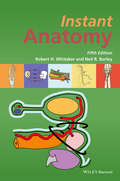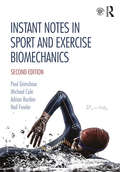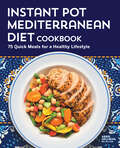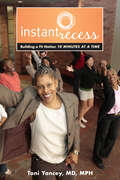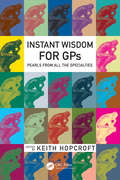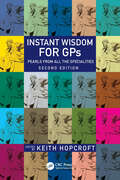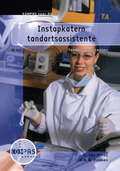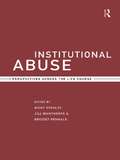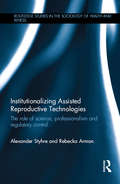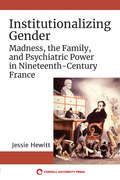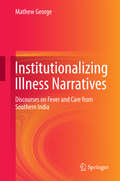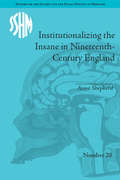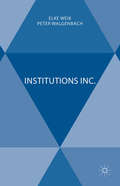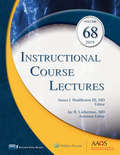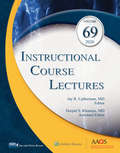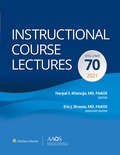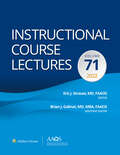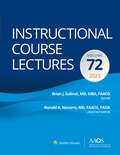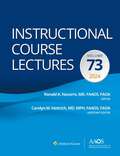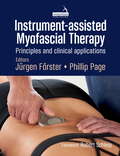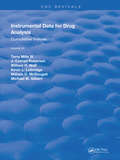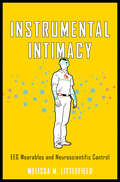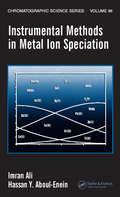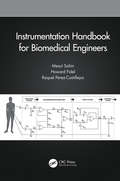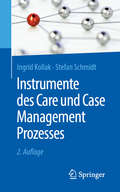- Table View
- List View
Instant Anatomy
by Neil R. Borley Robert H. WhitakerInstant Anatomy presents anatomy and anatomical relationships in a simple, unique, schematic manner to aid the speedy understanding and retrieval of anatomical facts. It shows structures such as nerves and blood vessels in their entirety, unlike the partial, regional presentations given in most textbooks. Covering the major aspects of anatomy, each section presents the relevant structures in double page spreads, with clear, full-colour diagrams on the left and concise text for each structure on the right. This new fifth edition includes more surface anatomy such as new myotome maps, bones of the hands and feet, principles of movement at shoulder and hip and images to clarify the understanding of the inguinal region and the lesser sac of the stomach.Ideal for use alongside a core anatomy textbook, Instant Anatomy is the perfect quick reference guide for medical students, surgeons, radiologists and those in many other specialties. The companion website at www.instantanatomy.net with its podcasts and wide ranging multiple choice questions provide invaluable exam preparation.
Instant Notes in Sport and Exercise Biomechanics: Second Edition (Instant Notes Ser.)
by Michael Cole Adrian Burden Paul Grimshaw Neil FowlerThis is the clearest and most straightforward biomechanics textbook currently available. By breaking down the challenging subject of sport and exercise biomechanics into short thematic sections, it enables students to grasp each topic quickly and easily, and provides lecturers with a flexible resource that they can use to support any introductory course on biomechanics. The book contains a wealth of useful features for teaching and learning, including clear definitions of key terms, lots of applied examples, guides to further reading, and revision questions with worked solutions. It has been significantly expanded to encompass rapidly developing areas, such as sports equipment design and modern optoelectronic motion analysis systems, and it includes a number of new sections that further develop the application of biomechanics in sports performance and injury prevention. A new companion website includes a test bank, downloadable illustrations and, where appropriate, suggestions for learning outcomes and/or lab-based sessions for lecturers. Instant Notes in Sport and Exercise Biomechanics has been an invaluable course companion for thousands of students and lecturers over the last decade. Engaging, direct, and now fully refreshed, it is the only biomechanics textbook you’ll ever need.
Instant Pot Mediterranean Diet Cookbook: 75 Quick Meals for a Healthy Lifestyle
by Abbie Gellman MS, RD, CDNMake quick and easy Mediterranean meals in your Instant Pot The Mediterranean diet is a style of eating renowned for its health benefits—and thanks to the Instant Pot it's easier than ever to bring the flavors of places like Italy, Greece, and Spain to your dinner table. This must-have cookbook includes mouthwatering Mediterranean meals created especially for your Instant Pot. The best part? Every recipe uses familiar ingredients you can find at your local grocery store. What sets this Mediterranean diet book apart from other Instant Pot Cookbooks: Mediterranean diet and Instant Pot basics—Learn all about the Mediterranean diet, and discover how Instant Pots are the perfect way to ensure Mediterranean dishes retain even more flavor and nutrients. Build your Mediterranean kitchen—You're likely to have many of the Mediterranean diet essentials at home already, and with the included lists of helpful tools and ingredients, getting started is a breeze. Easy Mediterranean meals—Create the tastes of paradise in your Instant Pot with simple recipes that feature fresh, whole foods like fruits, vegetables, beans, and lean protein. Make tasty Mediterranean meals with the push of a button using The Instant Pot Mediterranean Diet Cookbook.
Instant Recess: Building a Fit Nation 10 Minutes at a Time
by Toni YanceyThis lively, inspiring, and informative book zeroes in on the state of American fitness—persistently sedentary, plagued by obesity—and issues a clarion call to action that reaches across economic, racial, and educational lines. Toni Yancey finds that despite our best intentions and repeated resolutions to exercise, as well as a 40-year investment in fitness education and counseling, physical activity in all levels of society continues to plummet. In a warm, reader-friendly narrative that draws on solid scientific research, personal experience, and her own poetry, Yancey calls for a radically different approach: one that respects diversity and is grounded in the cultures of those most at risk. Instant Recess proposes regular ten-minute exercise breaks that utilize music and dance and are easily incorporated into school, work, and community life. Rather than encouraging unhealthful habits like cigarette breaks or high fat snacks, these "instant recesses" make the active choice the natural one. Here is a new paradigm for fitness and public health that promises vitality, well being, and a greater sense of community—demonstrating, as Yancey argues, that what’s good for the waistline is good for the bottom line.
Instant Wisdom for GPs: Pearls from All the Specialities
by Keith HopcroftThis essential guide for GPs distils years of knowledge, experience, and key evidence into 25 easy-to-read chapters, each one covering a different speciality. Every consultant has pearls of wisdom they wish they could share with GPs: knowledge they have acquired from years of experience and evidence-based study, which could lead to better patient care and more efficient use of resources. Instant Wisdom for GPs gathers these pearls together, presenting ten bullet-point gems from each speciality, together with advice on overlooked or obscure diagnoses, guidance on how to distinguish tricky differentials, and tips on prescribing. Each of these 25 chapters is written by an expert with lengthy experience in his or her field: Cardiology Ophthalmology Gynaecology ENT Renal General Practice Orthopaedic Haematology Psychiatry Neurology Diabetes Urology Functional Symptoms Respiratory General Surgery Oncology Thyroid Disease Paediatrics Sexual Health Rheumatology Care of the Elderly Dermatology Palliative Care Allergy Gastroenterology From the author of the critically acclaimed Symptom Sorter.
Instant Wisdom for GPs: Pearls from All the Specialities
by Keith HopcroftEvery consultant has pearls of wisdom they wish they could share with GPs: knowledge they have acquired from years of experience and evidence-based study, which could lead to improved speed and decision in referral, more efficient use of resources and, overall, better patient care. Instant Wisdom for GPs gathers these pearls together, presenting ten bullet-point gems from a comprehensive range of clinical specialties, together with advice on obscure or overlooked diagnoses, guidance on how to distinguish tricky differentials and tips on prescribing. The content has been thoroughly revised and updated for this second edition. New chapters have been added on alcohol use disorders, behavioural problems in children, clinical biochemistry, emergency presentations, genetics and genomics, obesity and bariatric medicine, and women’s health, all from contributors expert in these fields. Key Features: Each specialty chapter offers ten pearls of wisdom, with detailed explanation from a leading consultant 'Obscure or overlooked diagnoses’ flag conditions which the GP might not have heard about or might overlook or confuse with others ‘Easily confused’ sections highlight at-a-glance diagnoses which can be challenging to distinguish from each other, presented in an easy-to-read table ‘Prescribing points’ in each chapter highlight relevant issues around prescribing, including tips, warnings and clarifications Fully revised and updated with six new chapters Edited by Keith Hopcroft, author of the critically acclaimed Symptom Sorter, this practical and accessible guide distils years of knowledge, experience, and key evidence into 32 concise and easy-to-navigate chapters and is essential reading for trainee and practicing GPs.
Instapkatern tandartsassistente
by E. Van Kraaij J.A.M.M. Prinsen J. C. Brinkman NMT Ned Mij tot Bev TandheelkundeInhoud:Beroepsprofiel Mondzorg De intake De intake Infectiepreventie Mondonderzoek Administrati
Institutional Abuse: Perspectives Across the Life Course
by Nicky Stanley Jill Manthorpe Bridget PenhaleInstitutional Abuse brings together a number of different research studies and accounts of institutional abuse from leading academics and researchers. Public enquiries and court cases concerning institutional abuse in a range of settings have generated considerable media interest and have highlighted the need for preventative strategies and appropriate responses. Four areas of abuse are covered: *the abuse of children *the abuse of adults with mental health problems *the abuse of adults with learning difficulties *the abuse of older people. Each section includes a chapter which reports on users' experiences of abuse and their views as to how institutional abuse can be prevented and survivors' needs met.
Institutionalizing Assisted Reproductive Technologies: The Role of Science, Professionalism, and Regulatory Control
by Alexander Styhre Rebecka ArmanReproductive medicine has been very successful at developing new therapies in recent years and people having difficulties conceiving have more options available to them than ever before. These developments have led to a new institutional landscape emerging and this innovative volume explores how health and social structures are being developed and reconfigured to take into account the increased use of assisted reproductive technologies, such as IVF treatments. Using Sweden as a central case study, it explores how the process of institutionalizing new assisted reproductive technologies includes regulatory agencies, ethical committees, political bodies and discourses, scientific communities, patient and activists groups, and entrepreneurial activities in the existing clinics and new entrants to the industry. It draws on new theoretical developments in institutional theory and outlines how health innovations are always embedded in social relations including ethical, political, and financial concerns. This book will be of interest to advanced students and academics in health management, science and technology studies, the sociology of health and illness and organisational theory.
Institutionalizing Gender: Madness, the Family, and Psychiatric Power in Nineteenth-Century France
by Jessie HewittThis book examines the influence of gender and family values on the development of nineteenth-century French psychiatry.
Institutionalizing Illness Narratives
by Mathew GeorgeThis book is an ethnographic work that uses a critical medical anthropology approach to examine the concept of fever care in the context of southern India. Through a study of fevers, the study provides a critical overview to medical practice itself, as it is said that the history of fevers is also the history of medicine. This association between fevers and medicine is as relevant today, as this in-depth study of fever care reveals. Acknowledging the central role of health institutions in creating and propagating notions about illness in society, the author examines fever care through a study of hospitals. The study examines various discourses on fevers prevalent in the southern state of Kerala, which influence policy and programmatic dimensions of the state health services system. Fever care implies those aspects related to provisioning and cost involved among public and private sector hospitals. A second and more important dimension of this book is a critique of the culture of biomedical practice, informed by the social constructivist framework and approaches in the field of science studies. Overall, the book studies the processes by which physical symptoms like fever are treated as epidemics to be controlled, and are therefore brought within a biomedical system, thereby opening up options for commercialization of care.
Institutionalizing the Insane in Nineteenth-Century England (Studies for the Society for the Social History of Medicine #20)
by Anna ShepherdThe nineteenth century brought an increased awareness of mental disorder, epitomized in the Asylum Acts of 1808 and 1845. Shepherd looks at two very different institutions to provide a nuanced account of the nineteenth-century mental health system.
Institutions Inc.
by Peter Walgenbach Elke WeikInstitutions Incorporated draws together aspects of human and organizational corporeality and links them to institutions. Throughout European anthropology and culture the body has been conceptualized as the 'dark side' to soul and reason. This book explores the 'dark side' of institutions, their materiality and the bodily involvement of their users, in an environment where perfection is measured in intangible entities, notably reason and will. This innovative collection takes a closer look at the interplay of the symbolic and the material, and the triad of institutions, bodies and corporations. This exciting research examines what the tangible, 'dark side' of institutions means both for those who live in them, and those who study them.
Instructional Course Lectures, Volume 68
by James I. Huddleston III Jay R. LiebermanPublisher's Note: Products purchased from 3rd Party sellers are not guaranteed by the Publisher for quality, authenticity, or access to any online entitlements included with the product. Lead innovation and raise the standard of care in your OR with new techniques and proven practical approaches presented at the definitive orthopaedic educational event of 2018 – the AAOS Annual Meeting.
Instructional Course Lectures, Volume 69: Ebook without Multimedia
by Jay R. Lieberman Harpal Paul KhanujaLead innovation and raise the standard of care in your OR with new techniques and proven practical approaches presented at the definitive orthopaedic educational event of 2019—the American Academy of Orthopaedic Surgeons (AAOS) Annual Meeting. Filled with current, clinically relevant presentations and approaches, Instructional Course Lectures, Volume 69 offers solutions for the most current issues and challenges faced at all stages of your career. Broaden your treatment options with experience-based solutions from some of today’s most respected surgeons and specialty experts.
Instructional Course Lectures: Volume 70
by Eric Strauss Harpal Paul KhanujaLead innovation and raise the standard of care in your OR with new techniques and proven practical approaches. Filled with current, clinically relevant presentations and approaches, Instructional Course Lectures, Volume 70 offers solutions for the most current issues and challenges faced at all stages of your career. Broaden your treatment options with experience-based solutions from some of today’s most respected surgeons and specialty experts.
Instructional Course Lectures: Volume 71 (AAOS - American Academy of Orthopaedic Surgeons)
by Eric Strauss Brian GalinatDeveloped in partnership with the American Academy of Orthopaedic Surgeons (AAOS) and edited by Eric J. Strauss, MD, FAAOS (editor) and Brian J. Galinat, MD, MBA, FAAOS (assistant editor), Instructional Course Lectures, Volume 71 offers solutions for the most current issues and challenges faced at all stages of your career. Filled with current, clinically relevant presentations and approaches, the book broadens your treatment options with experience-based solutions from today’s most respected surgeons and specialty experts. Based on selected Instructional Course Lectures presented at the AAOS Annual Meeting 2021 in San Diego Lead innovation and raise the standard of care in your operating room with new techniques and proven practical approaches. Expand and refresh your general orthopaedic, specialty, and practice knowledge Learn new approaches and surgical techniques from thought leaders Update your action plans for rehabilitative care with expert insights Review new techniques for solving the tough challenges you encounter in your practice every day Chapters are abundantly illustrated with radiographs, drawings, and intraoperative photographs. Some chapters are enhanced with video that bring the techniques to life
Instructional Course Lectures: Volume 72
by Brian J. Galinat Ronald A. NavarroDeveloped in partnership with the American Academy of Orthopaedic Surgeons (AAOS) and edited by Brian J. Galinat, MD, MBA, FAAOS (editor) and Ronald A. Navarro, MD, FAAOS (assistant editor),Instructional Course Lectures, Volume 72 offers current, clinically relevant information across a broad spectrum of orthopaedic topics. These lectures were written by the orthopaedic surgeons who presented at the 2022 AAOS Annual Meeting. This all-new volume covers topics such as increasing diversity in orthopaedics, controversies in total knee replacement, biologics and sports medicine, endoscopic spine surgery, and more.
Instructional Course Lectures: Volume 73
by Ronald A. Navarro Carolyn M. HettrichDeveloped in partnership with the American Academy of Orthopaedic Surgeons (AAOS) and edited by Ronald A. Navarro, MD, FAAOS, FAOA (editor) and Carolyn M. Hettrich, MD, MPH, FAAOS (assistant editor), Instructional Course Lectures, Volume 73 offers current, clinically relevant information across a broad spectrum of orthopaedic topics. These lectures were written by the orthopaedic surgeons who presented at the 2023 AAOS Annual Meeting. This all-new volume covers topics such as: • From Platelet-Rich Plasma to Mesenchymal Stem Cells: Cartilage Regeneration With Orthobiologics • Patient Reported Outcome Measures – How to Get the Most Out of Them and Mitigate Health Care Disparities • Leveraging Artificial Intelligence and Digital Health to Address Health-Related Social Needs and Optimize Risk-Based Value in Orthopaedic Surgery • Peri-articular Injection and Peripheral Nerve Blocks With Standard Agents • Management of Acute Diabetic Ankle Fractures • And many more
Instrument-assisted Myofascial Therapy: Principles and Clinical Applications
by Phil Page Jürgen FörsterInstrument-Assisted Myofascial Therapy: Principles and Clinical Applications provides a complete overview of this effective therapy (IAMT) based on the authors' own clinical experience of using instruments to treat myofascial lesions. The text combines the latest scientific evidence and theory with practical guidelines. The authors describe the use of various IAMT techniques which the reader will be able to easily integrate into daily clinical practice.The text progresses from didactic to practical information of relevance for a variety of clinicians:- Anatomy of the myofascial system and its role in pain/dysfunction and treatments- Science and theory of IAMT including history, types, and research on mechanisms of action and outcomes- Practical application of IAMT Practice: an overview of techniques specific to tissue type (scars, tendons, muscles)- Integration of IATM in clinical practice including clinical decision making (in diagnosis and treatment), indications, contraindications, and adjunct treatmentsThe text is intended to provide a guide for using myofascial instruments in daily practice. The reader will easily learn how to use IATM to enhance patient outcomes and to use it in a fashion which protects their own joints! Procedures are explained and demonstrated using a clear and practical approach. Full-color photographs illustrate the use of the therapy in these commonly-treated areas: Cervical spine and head, Shoulder, Elbow, wrist and hand, Thoracic spine and chest, Lumbar spine and sacroiliac joint, Hip and pelvis, Knee, Ankle and foot.Treatment protocols are provided which can be easily applied by the therapist for use with a variety of diagnoses relating to the same structures by using a standardised and precise approach. A treatment protocol is first presented on a specific structure that is commonly treated. The specific instrument is to be used is described first, then the entire treatment is explained in detail. from the starting position of the therapist and patient. Treatment progressions are then listed, as well as possible treatment options within the Myofascial Connective System (MCS). Beginning with the primarily treated structure, 'myofascial junctions' are discussed; first regionally in a distal and proximal direction, and then within a functional myofascial chain. This unique approach greatly simplifies the various IATM procedures for the reader to easily implement in practice.Readers will learn an integrated approach to IATM in a variety of clinical practice settings. Clinicians seeing post-operative patients will benefit from a chapter dedicated to the treatment of scars. Numerous case studies and the integration of other myofascial techniques (Cupping, Flossing/Mobility Bands, Kinesiology Taping and Fascial Fitness) complete the book.Instrument-Assisted Myofascial Therapy - principles and clinical applications is the result of years of professional practice with IATM while evaluating patient outcomes. The concept is based on scientific evidence and has been developed in close collaboration with leading scientists and practitioners in the field of myofascial therapy. The text provides a pragmatic, evidence-informed approach to IATM practice.
Instrumental Data for Drug Analysis, Second Edition: Volume VII (Forensic And Police Science Ser.)
by Terry MillsVolume 7 of this classic collection presents a comprehensive index to the first six volumes, providing quick and easy access to the data in this exhaustive resource, and completing the set.
Instrumental Intimacy: EEG Wearables and Neuroscientific Control
by Melissa M. LittlefieldA critical examination of the rise of wearable EEG monitors.From Fitbits to GPS trackers, wearables promise to help us understand and improve ourselves in quantified ways. We count our steps, track our location, and even monitor our brain waves as we strive to achieve better fitness, clearer direction, or a more focused mind. But why do we rely on wearables to learn about ourselves? In Instrumental Intimacy, Melissa M. Littlefield questions our desire for mechanistic guidance by examining brain-based EEG wearables that promise to improve sleep, relationships, self-knowledge, and learning. Littlefield focuses specifically on EEGs’ transition out of the laboratory and into the hands of consumers. While other brain-imaging technologies (such as MRI, PET, and MEG) are used only in specialized laboratories, human electroencephalography (a.k.a. EEG) is embedded in portable, user-friendly devices. These direct-to-consumer wearables visualize brain activity as accessible data, and many offer the promise of self-optimization.Littlefield’s illuminating book brings the histories of EEG to bear on the contemporary development of EEG wearables via case studies of EEG-based sleep aids, bio-mapping instruments, fashionable surveillance tools, and athletic training devices. The author argues that, over the past century, applied uses of EEG helped to create new states of mind to be monitored and manipulated, as well as discourses about the existence of brain waves and their viability as a tool for brain optimization. By contextualizing and analyzing EEG wearables, Instrumental Intimacy provides a crucial intervention in an emergent consumer market and in the scholarly fields of STS, critical neuroscience, and the history of technology.
Instrumental Methods in Metal Ion Speciation
by Imran Ali Hassan Y. Aboul-EneinThe knowledge of metal ion speciation is essential for predicting the exact toxicities of metal ion species in the environment. Metal ions can exist in various oxidation states, each of which possesses different physical and chemical properties as well as exhibit varying toxicities. Often, toxicity data is unreliable because it is based on metal io
Instrumentation Handbook for Biomedical Engineers
by Mesut SahinThe book fills a void as a textbook with hands-on laboratory exercises designed for biomedical engineering undergraduates in their senior year or the first year of graduate studies specializing in electrical aspects of bioinstrumentation. Each laboratory exercise concentrates on measuring a biophysical or biomedical entity, such as force, blood pressure, temperature, heart rate, respiratory rate, etc., and guides students though all the way from sensor level to data acquisition and analysis on the computer. The book distinguishes itself from others by providing electrical circuits and other measurement setups that have been tested by the authors while teaching undergraduate classes at their home institute over many years. Key Features:• Hands-on laboratory exercises on measurements of biophysical and biomedical variables• Each laboratory exercise is complete by itself and they can be covered in any sequence desired by the instructor during the semester• Electronic equipment and supplies required are typical for biomedical engineering departments • Data collected by undergraduate students and data analysis results are provided as samples• Additional information and references are included for preparing a report or further reading at the end of each chapter Students using this book are expected to have basic knowledge of electrical circuits and troubleshooting. Practical information on circuit components, basic laboratory equipment, and circuit troubleshooting is also provided in the first chapter of the book.
Instrumente des Care und Case Management Prozesses
by Stefan Schmidt Ingrid KollakKomplexe Prozesse professionell überblicken und gekonnt zum Ziel führen!Dieses Buch bietet Fachpersonen aus dem Bereich Pflege und Gesundheitsversorgung einen konzentrierten Einblick über die Instrumente des Care und Case Management Prozesses.Lernen Sie die vielschichtigen Abläufe geschickt zu strukturieren und zielorientiert zu steuern. Mit Hilfe der vorgestellten Instrumente gestalten Sie die einzelnen Prozessphasen positiv und decken konkret die Ressourcen und Bedarfe Ihrer Patienten auf. Sie ermöglichen eine effiziente interdisziplinäre Arbeit und helfen, die vollbrachten Leistungen zu evaluieren.
